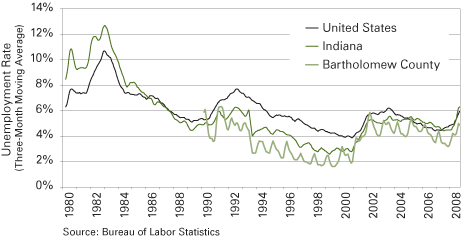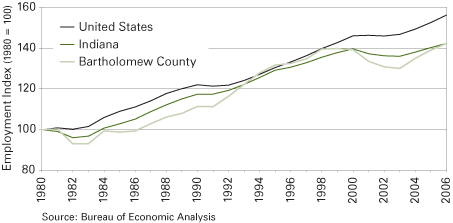Columbus Forecast 2009
Senior Lecturer in Finance and Co-Director: Center for Econometric Model Research, Kelley School of Business, Indiana University
November 2008
Columbus and Bartholomew County have always depended on manufacturing for their economic health. Given that the nation's manufacturing sector typically contracts sharply in a recession, recessions have hit hard in Indiana and Bartholomew County. This time, however, we may dodge a bullet—or at least the biggest bullets.
The worst U.S. recession in recent memory took place in 1981–1982. In December 1982, the unemployment rate in Indiana reached 12.5 percent. The national rate peaked at 10.8 percent. Figure 1 shows the three-month moving average for unemployment rates.
Figure 1: Unemployment Rates, Three-Month Moving Average, 1980 to 2008

Data on unemployment rates by county are not available for that period, but we know that thousands of local people lost their jobs. During 1982, Bartholomew County lost in excess of 2,700 jobs, more than 7 percent of its total employment. In relative terms, job losses the county were far worse than the national average. When employment numbers are indexed to 1980, the damage is obvious (see Figure 2). Indiana and Bartholomew County suffered much more than the nation in that recession.
Figure 2: Employment Index, 1980 to 2006

During the recession of 1991–1992, however, Bartholomew County did not reprise its poor 1982 performance. The unemployment rate hit 7.8 percent nationwide, but topped out at about 6.3 percent in Indiana and 6.6 percent in Bartholomew County.
When the next recession took hold in 2001, it brought a big decline in durable goods sales. Employment in Indiana and Bartholomew County once again fell more steeply than in the nation as a whole. The actual rate of unemployment, however, was never much worse than the national average.
Our forecast for Columbus and Bartholomew County in the recession of 2008–2009 is not as gloomy as the forecast for the nation. Bartholomew County is better prepared than most areas to defend itself against the coming slowdown. There are at least three reasons for this.
- Indiana in general did not experience the bubble in housing prices that occurred in other parts of the country. Now that the bubble has burst, we don't have as far to fall.
- The economic activity in Columbus and Bartholomew County has become more diversified. In 1980, heading into that awful recession, 43 percent of the county's jobs were in manufacturing. Today that figure is about 28 percent. Over a period of many years, economic development leaders here have made wise and productive decisions.
Indeed, during the 2001 recession, employment actually expanded in the sectors of health care, finance, and professional services. Those three sectors together now account for nearly 15 percent of jobs in the county. The Center for Econometric Model Research at Indiana University predicts that the Columbus metro area will be one of the best performers among all Indiana metro areas in 2009. - Several major employers in the Columbus area are well-positioned to face the pressures of a recession. Three big organizations appear to be particularly well-managed.
- The hospital has just re-opened after the June flood. Though it laid off a few workers while it was closed, this major regional medical facility will certainly give rise to more jobs and more payroll dollars as it regains its momentum.
- Cummins' headquarters and central design functions remain here, but the company has built up businesses in dozens of other countries and in a wide array of new product lines. At the end of October, a Standard & Poor's stock research report on Cummins predicted profit growth from margin improvement, technology leadership, and strong (though perhaps slowing) new markets. Caterpillar's decision to withdraw from the on-highway truck engine business also helps by removing a source of competition. Cummins' presence in Columbus is likely to be much more stable during 2009 than in past recessions.
- Irwin Financial has been bloodied by the general epidemic of losses afflicting the financial services industry, but there are signs that the worst is behind it. As long as the global banking industry produces no more big calamities, this company has a good chance of squeaking through the recession in 2009 without major layoffs.
While these factors are encouraging, recessions are still nasty things. And this one looks like it will last awhile. Certain sectors of the Columbus area economy will get hurt, and our workforce will suffer further layoffs. The local unemployment rate, currently near 5 percent, is forecast to inch up past 6 percent this winter. But the unemployment rate already is nearly 8 percent in California and more than 8 percent in Michigan. The overall U.S. rate is predicted to be more than 7 percent by early 2009. Bartholomew County should stop well short of that figure.
Retail businesses, however, are likely to see further declines in revenue. New car sales have already dropped precipitously and will probably not recover much until the second half of 2009. Residential construction will continue to be depressed through most of 2009 by an inventory of unsold and foreclosed homes throughout the region.
But in important respects, the Columbus and Bartholomew County area has armored itself well against a recession. The county should be able to dodge most of the bullets hitting places like Michigan and California.
Also in this Issue…
- Outlook for 2009
- International Outlook for 2009
- U.S. Outlook for 2009
- Financial Outlook for 2009
- Housing Market Outlook for 2009
- Indiana's Outlook for 2009
- Indiana's Agricultural Outlook for 2009
- Indiana's Special Sectors Outlook for 2009
- Anderson Forecast 2009
- Bloomington Forecast 2009
- Columbus Forecast 2009
- Evansville Forecast 2009
- Fort Wayne Forecast 2009
- Gary Forecast 2009
- Indianapolis-Carmel Forecast 2009
- Kokomo Forecast 2009
- Louisville Forecast 2009
- Muncie Forecast 2009
- Richmond Forecast 2009
- South Bend and Elkhart Area Forecast 2009
- Terre Haute Forecast 2009
- Return to Table of Contents



